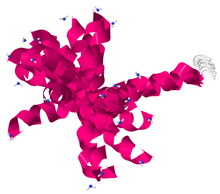Tämä asia on nyt hyönteisten peptidien puolelta, mutta näillä itikat saavat aikaan omaa vastustuskykyä virusta vastaan.Esim dengue -virus aiheuttaa että itikassa kehittyy jotain defensiiniå, peptidiä, ja se peptidi taas ilmenee itikan pureman yhteydessä itikan syljessä, ja ehkä pystyy tekemään reiän johonkin infektioketjussa tarvittavaan kohtaa. Mikä suhde DENV viruksella ja sen vektorihyönteisellä sitten on, molemmat ainakin lisääntyvät ihmisen kustannuksella.
Cecropin
From Wikipedia, the free encyclopedia
| Cecropin family | |||
|---|---|---|---|
 |
|||
| Identifiers | |||
| Symbol | Cecropin | ||
| Pfam | PF00272 | ||
| InterPro | IPR000875 | ||
| PROSITE | PDOC00241 | ||
| SCOP | 1f0d | ||
| SUPERFAMILY | 1f0d | ||
| TCDB | 1.C.17 | ||
| OPM superfamily | 160 | ||
| OPM protein | 1d9j | ||
|
|||
Cecropins[3][4][5] constitute a main part of the cell-free immunity of insects. Cecropins are small proteins of about 31 - 37 amino acid residues active against both Gram-positive and Gram-negative bacteria. Cecropins isolated from insects other than Hyalophora cecropia (Cecropia moth) have been given various names; bactericidin, lepidopteran, sarcotoxin, etc. All of these peptides are structurally related. Cecropin P1, an intestinal antibacterial peptide from Sus scrofa (Pig), also belongs to this family. Cecropin family also consists Cecropin A and Cecropin B.
Cecropin is an anticancer polypeptide(L). Structure consists of mainly alpha helixes, determined by solution NMR. Protein molecular weight = 4203.4g/mol.[6] At low peptide to lipid ratios ion channels are formed, at high peptide to lipid ratios pores are formed.[7]
DENGUE-virus ja sen itikassa aiheuttama ITIKAN DEFENSIINI
Luplertlop N, Surasombatpattana P, Patramool S, Dumas E, Wasinpiyamongkol L, Saune L, Hamel R, Bernard E, Sereno D, Thomas F, Piquemal D, Yssel H, Briant L, Missé D.PLoS Pathog. 2011 Jan 13;7(1):e1001252. doi: 10.1371/journal.ppat.1001252.3.Dhananjeyan KJ, Sivaperumal R, Paramasivan R, Thenmozhi V, Tyagi BK.J Mol Model. 2009 May;15(5):507-14. doi: 10.1007/s00894-008-0408-7. Epub 2008 Dec 16.- PMID:
- 19085024
- [PubMed - indexed for MEDLINE]
Inga kommentarer:
Skicka en kommentar